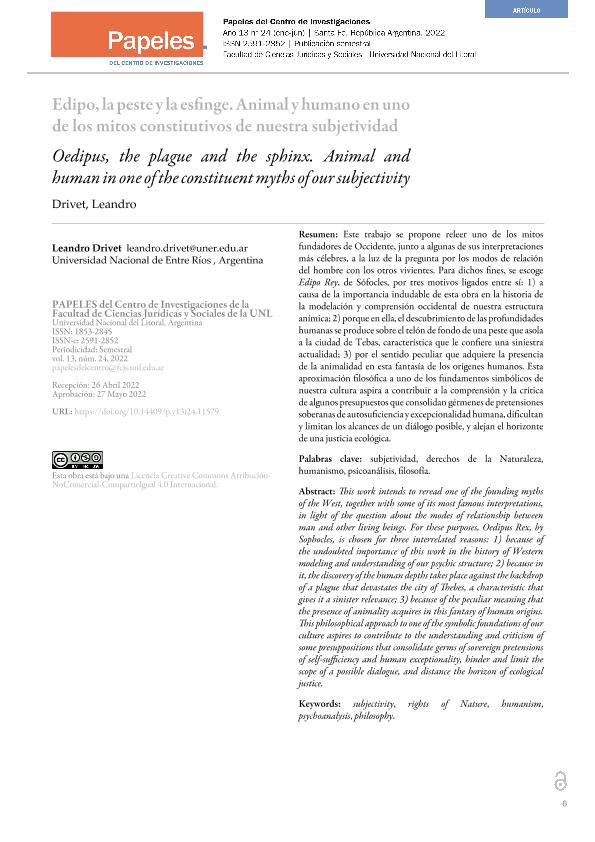Mostrar el registro sencillo del ítem
dc.contributor.author
Drivet, Leandro

dc.date.available
2023-06-15T13:03:24Z
dc.date.issued
2022-06
dc.identifier.citation
Drivet, Leandro; Edipo, la peste y la esfinge: Animal y humano en uno de los mitos constitutivos de nuestra subjetividad; Universidad Nacional del Litoral; Papeles; 13; 24; 6-2022; 6-14
dc.identifier.issn
1853-2845
dc.identifier.uri
http://hdl.handle.net/11336/200696
dc.description.abstract
Este trabajo se propone releer uno de los mitosfundadores de Occidente, junto a algunas de sus interpretacionesmás célebres, a la luz de la pregunta por los modos de relacióndel hombre con los otros vivientes. Para dichos fines, se escogeEdipo Rey, de Sófocles, por tres motivos ligados entre sí: 1) acausa de la importancia indudable de esta obra en la historia dela modelación y comprensión occidental de nuestra estructuraanímica; 2) porque en ella, el descubrimiento de las profundidadeshumanas se produce sobre el telón de fondo de una peste que asolaa la ciudad de Tebas, característica que le confiere una siniestraactualidad; 3) por el sentido peculiar que adquiere la presenciade la animalidad en esta fantasía de los orígenes humanos. Estaaproximación filosófica a uno de los fundamentos simbólicos denuestra cultura aspira a contribuir a la comprensión y la críticade algunos presupuestos que consolidan gérmenes de pretensionessoberanas de autosuficiencia y excepcionalidad humana, dificultany limitan los alcances de un diálogo posible, y alejan el horizontede una justicia ecológica.
dc.description.abstract
This work intends to reread one of the founding myths of the West, together with some of its most famous interpretations, in light of the question about the modes of relationship between man and other living beings. For these purposes, Oedipus Rex, by Sophocles, is chosen for three interrelated reasons: 1) because of the undoubted importance of this work in the history of Western modeling and understanding of our psychic structure; 2) because in it, the discovery of the human depths takes place against the backdrop of a plague that devastates the city of Thebes, a characteristic that gives it a sinister relevance; 3) because of the peculiar meaning that the presence of animality acquires in this fantasy of human origins. This philosophical approach to one of the symbolic foundations of our culture aspires to contribute to the understanding and criticism of some presuppositions that consolidate germs of sovereign pretensions of self-sufficiency and human exceptionality, hinder and limit the scope of a possible dialogue, and distance the horizon of ecological justice.
dc.format
application/pdf
dc.language.iso
spa
dc.publisher
Universidad Nacional del Litoral
dc.rights
info:eu-repo/semantics/openAccess
dc.rights.uri
https://creativecommons.org/licenses/by-nc-sa/2.5/ar/
dc.subject
SUBJETIVIDAD
dc.subject
DERECHOS DE LA NATURALEZA
dc.subject
HUMANISMO
dc.subject
PSICOANÁLISIS
dc.subject.classification
Ciencias Sociales Interdisciplinarias

dc.subject.classification
Otras Ciencias Sociales

dc.subject.classification
CIENCIAS SOCIALES

dc.title
Edipo, la peste y la esfinge: Animal y humano en uno de los mitos constitutivos de nuestra subjetividad
dc.title
Oedipus, the plague and the sphinx: Animal and human in one of the constituent myths of our subjectivity
dc.type
info:eu-repo/semantics/article
dc.type
info:ar-repo/semantics/artículo
dc.type
info:eu-repo/semantics/publishedVersion
dc.date.updated
2023-06-14T16:47:53Z
dc.identifier.eissn
2591-2852
dc.journal.volume
13
dc.journal.number
24
dc.journal.pagination
6-14
dc.journal.pais
Argentina

dc.journal.ciudad
Santa Fe
dc.description.fil
Fil: Drivet, Leandro. Universidad Nacional de Entre Ríos. Facultad de Ciencias de la Educación. Centro de Investigación en Filosofía Política y Epistemología; Argentina. Consejo Nacional de Investigaciones Científicas y Técnicas; Argentina
dc.journal.title
Papeles
dc.relation.alternativeid
info:eu-repo/semantics/altIdentifier/url/https://bibliotecavirtual.unl.edu.ar/publicaciones/index.php/papeles/article/view/11579
Archivos asociados
